Making Pork Pies

I have to admit, these Melton Mowbray-style pork pies aren’t something you just throw together, but for the serious pork pie enthusiast they are well worth the time and effort. To make them the old-fashioned way you’ll need an old-fashioned piece of equipment called a pie dolly plus some rendered leaf lard, for without good quality lard the side walls of the pie won’t stand up in the oven. Oh yes friends, these pies are baked free-standing, didn’t you know? Forms are for sissies. At least they are in Melton Mowbray.
That said you absolutely can adapt this recipe to more conventional ingredients and equipment. A standard hot water pie crust or even an American-style pie crust can be used along with a muffin tin or other form. They’ll come together in an afternoon. Personally, once I read about this technique I couldn’t resist trying it, even if it took three days. The result was the pork pie of the gods.
On day one you’ll need to make your hot water dough and let it chill for at least four hours or overnight (which is better). Next day, take the dough out of the refrigerator and let it warm back up to room temperature, about three hours. What’s the point of the chilling? To hydrate the flour but more importantly to re-firm the fat, since the firm fat helps keep the pie walls standing. But of course too firm is no good for rolling, so it needs to come back to room temperature at which point the fat will still be firm but plastic, and that’s what you want for shaping.
When you’re ready to shape, make your filling. Assemble the ingredients and combine the pork, bacon, salt pepper, spices an anchovy paste (the secret ingredient) in a food processor.
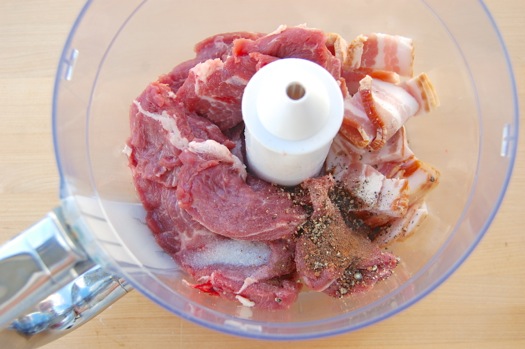
Pulse until the meat is chopped well, but no further. You don’t want it reduced to a paste. Set that aside while you get the dough ready.
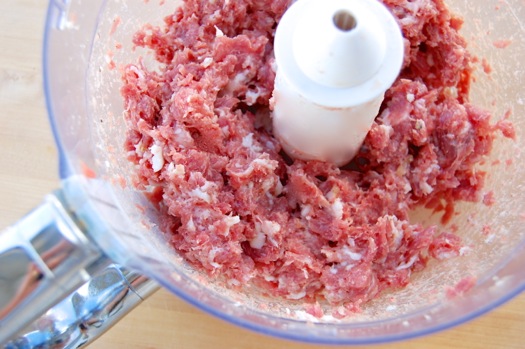
Produce your pie dolly and a round cutter (from a cutter set) that’s a bit larger than the circumference of the dolly.
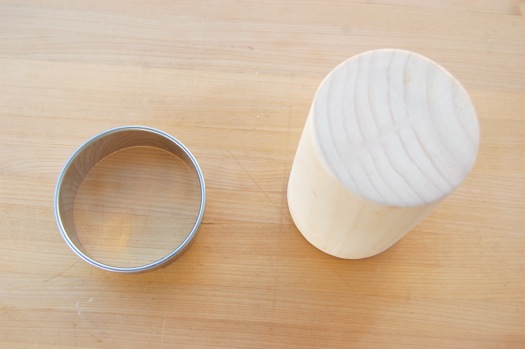
Now separate about a quarter of the dough and roll it to a little less that 1/4″ thick.
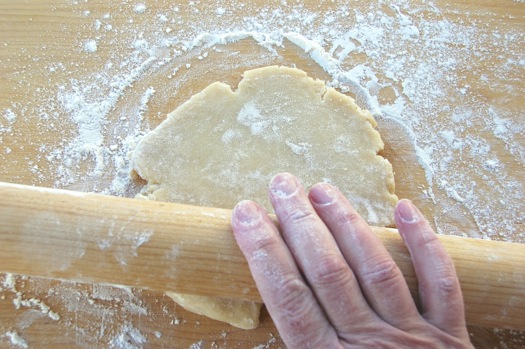
Cut out five circles (assuming your dolly is about the same size as mine) and reserve the scraps.

Poke a hole in the centers with a dowel or some other device. Here I’m using a funnel, which is just about perfect, even though the holes it makes aren’t perfectly round. Who cares?

They look good to me!

Now for the shaping. This is really fun. Take a 4.5-ounce piece of dough…
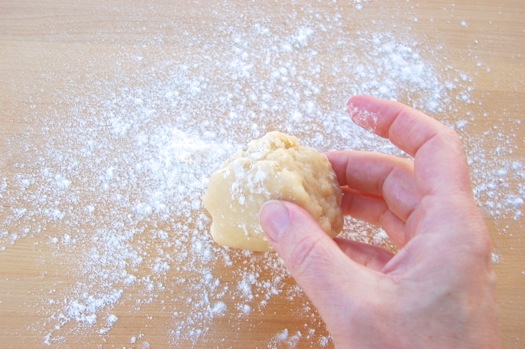
…roll it into a ball…
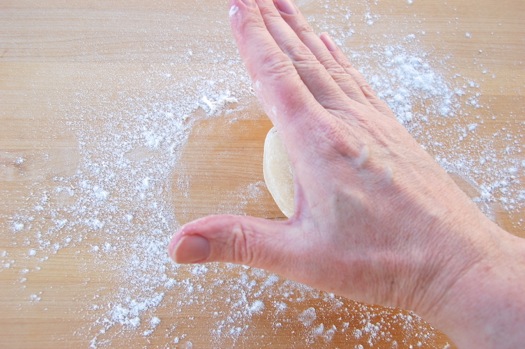
…and pat it down into a circle.
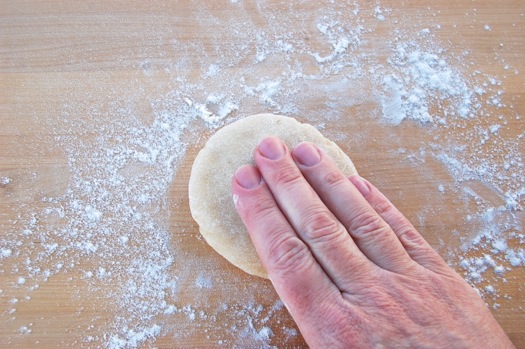
Now apply the pie dolly and press down hard. I mean really hard…like lean well over it and put your weight on it. You’re trying to crush the center down to about 1/4 inch. If you’re unsure how you’re doing just take the dolly off, pick up the dough and pinch it. If it’s thicker that a pie bottom ought to be, keep pressing. You may get a couple of big splits, that’s not a problem.
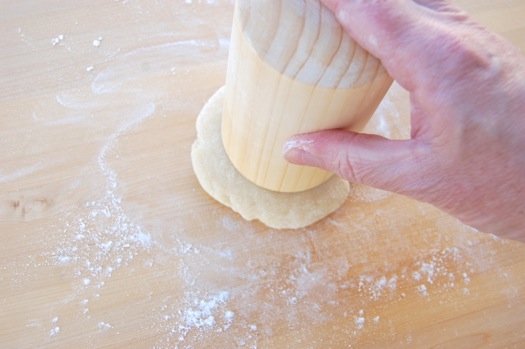
Once the bottom is thin enough, it’s time to shape the sides. Here I should say you want to use as little flour as you possibly can. Flour really won’t help with sticking and will create a flat, flaky finish on the outside of the crust when the pie is baked. A very slight dusting is all the more you need. Now then. Plant your thumbs on the top of the dolly…
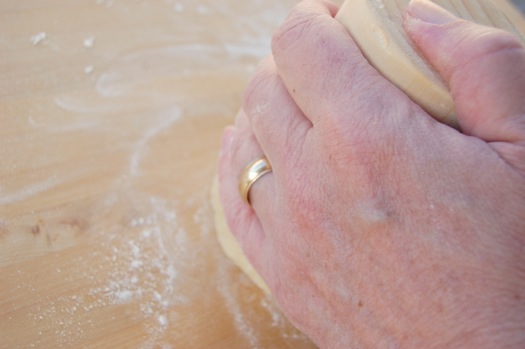
…and start squeezing with your pinkies, firmly and steadily stretching the dough up the sides. Take your time…there’s no hurry here. Press together any splits in the dough, without extra flour on the dough they’ll come together easily.
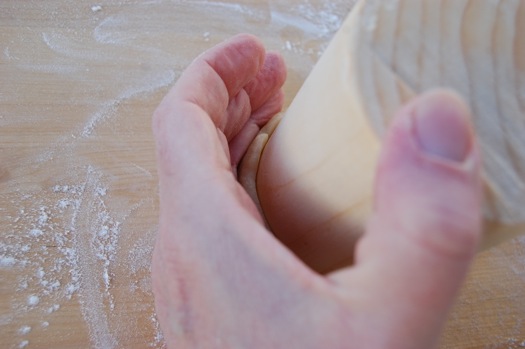
After a few minutes of pressing and rotating the dolly, it’ll look about like this.
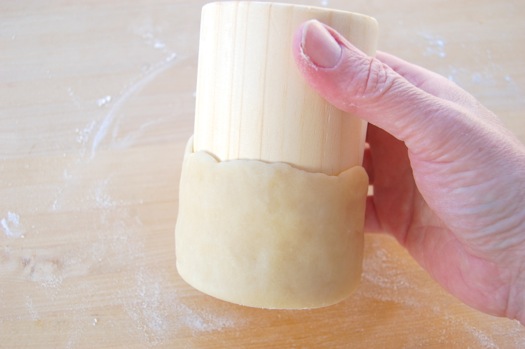
Now slip off the dolly and…your shell is done. I noticed that some of my pie shells came off more easily that others. One stuck pretty seriously, so I used a wooden coffee stirrer to loosen it. It came off easily after that. Should your walls get compacted during removal, just pinch them thin again.

Plop a ball of filling in…enough to come within about 3/4″ from the rim. The apply a top. If it’s not big enough, roll it a little more the pin.
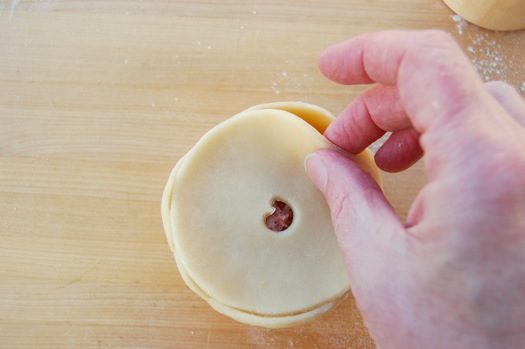
Pinch it all the way around to seal.
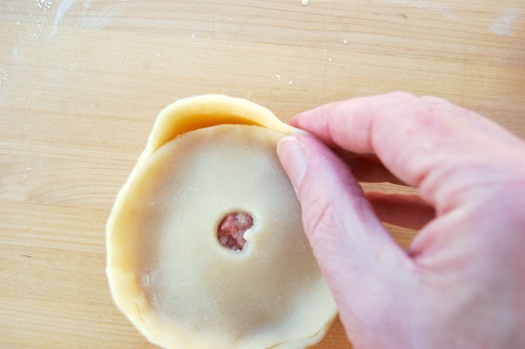
You can leave it like that, press the edge with a fork to give it a decorative frill, or curl it over, which is what I did.
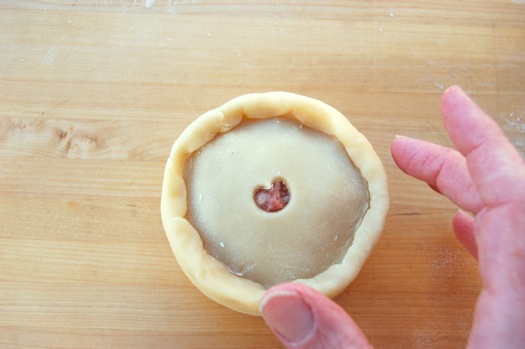
Once that’s done it’s time to rest the pies for a minimum of three hours, though overnight is better. The long rest not only relaxes the dough, it chills the filling thoroughly, and that’s important because a nicely chilled center will help keep the fat in the walls cool even after the pie has gone into the oven. And that’s important. Why? Because the residual chill will help keep interior of the wall firm while the oven’s heat gelates and sets the starch on the exterior. The result being that the unusually tall walls stay up without bowling outward or compressing. Pretty neat.
Now then, when it’s time to bake preheat your oven to 400 degrees Fahrenheit (the high heat will set the outside of the crust quickly). Paint the pies with egg wash and promptly get them in the oven.
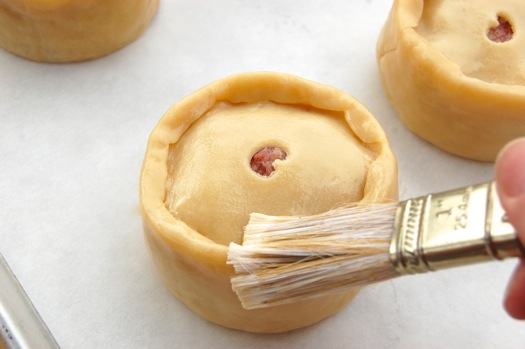
Bake them on a middle rack for half an hour, until they start taking on color. Open the oven, rotate the pan and reduce the heat to 350. Keep baking at least another half an hour until the pies are golden and a thermometer inserted into the middle of the pie through the ventilation hole registers 180 or more. If the crust starts getting too dark, tent them with tin foil.

Allow the pies to cool completely. At this point you can eat them, or press on and add the final touch that marks a true Melton Mowbray-style pork pie: the “jelly”. Adding that means another deep chill in the fridge. A minimum of three hours though — say it will me — overnight is better. Why is this important? Because your gelatin-rich stock will be very fluid before you pour it in. to prevent it running out all over the place — as it will even through a well-formed crust — it needs to firm fast. A very cold pie will chill it quick. Pour it in until it reaches the top. I couldn’t get pork bones at the butcher so this is some home-made chicken stock. Works every bit as well. If you really like jelly in your pork pies, do a second application after about five minutes to make sure it completely fill sin the interior gaps.
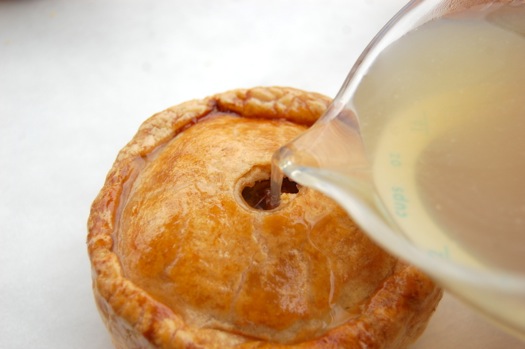
The good news is that after this step they’re ready to eat as the jelly takes only about five or ten minutes to set. Of course, allowing them to warm for an hour or so is best. I know, it’s even more waiting, but friends you’ll be happy you did. Pour yourself a pint of good ale, cut a piece, close your eyes and pretend you’re in the Midlands.

Cheers!
This looks DELICIOUS and I’m firmly in the “gelatin is gross” camp. So that’s a testimony to how appealing you’ve made it seem and look!
Ha! Thanks, K-Line! You can make them without the jelly for sure. They’re very good that way as well!
– Joe
Beautiful, Joe… simply beautiful. And I’ll bet they were tasty too!
Thanks, Brian!
And you know I have to say they were very good. I bought some brown ale, invited a few friends over and they were gone in a heartbeat — polar vortex be damned! A good winter’s dinner despite the weather.
Thanks for checking in, Brian!
– Joe
Thank you for the crust and pork pie recipe!
I had fun, Sosha!
Cheerio,
– Joe
Here you go, Joe. You might find this related information to be of interest.
http://www.cbc.ca/asithappens/features/2014/03/03/cornish-pasty-ambassador/
Ha! Love that, Ted. Thanks!
– Joe
Hi Joe,
I am wondering if these little beauties freeze well? And at what point in the process? Pre-baking? Post-baking, but pre-jellygoodness injection?
I cannot wait to tackle these (my British husband is very on-board with this plan) but I would like to save a few, as it is just the two of us.
Any advice?
Loving your blog as always!
Kathleen
Hey Kathleen!
You nailed it: after shaping and before baking is the right time to freeze them. You can keep the stock frozen for when you’re ready. You can bake, let them cool down and pour in the jelly afterward. Serve!
Let me know what your husband thinks!
– Joe
Those are some beautiful looking pies.
Thank you, Stacey! They were fun to make. I’d never used a pie dolly before…a pretty cool thing!
Thanks for the comment,
– Joe